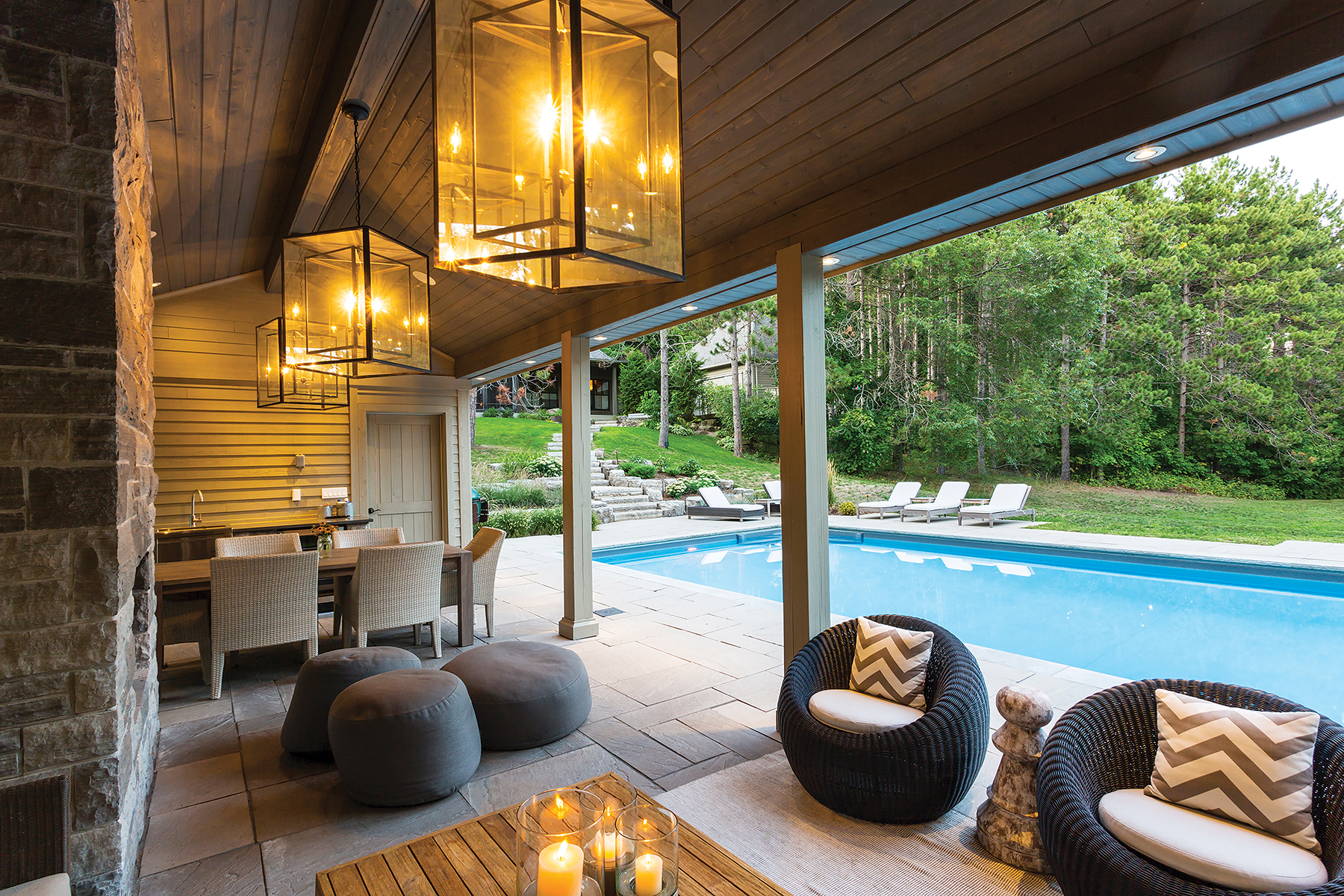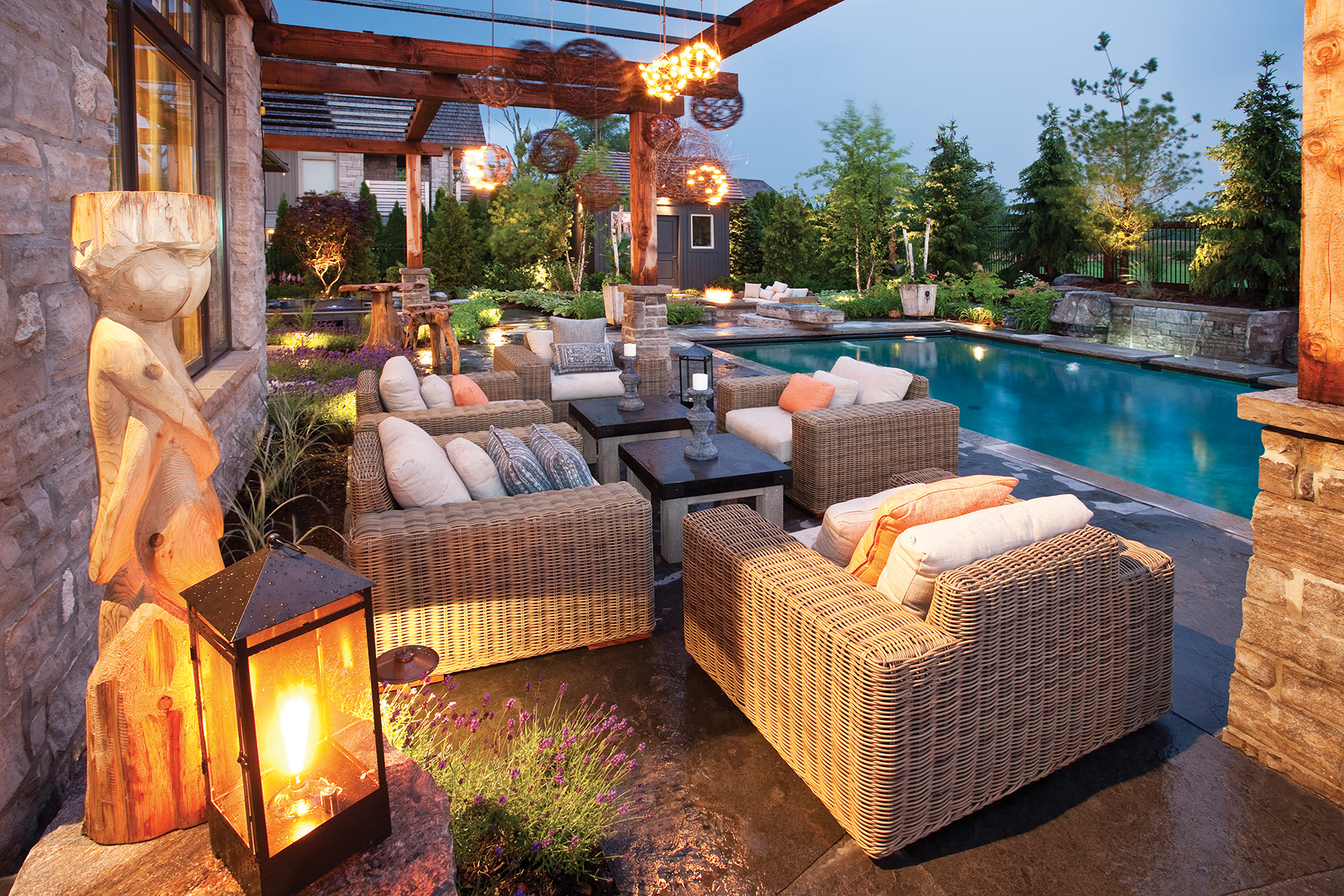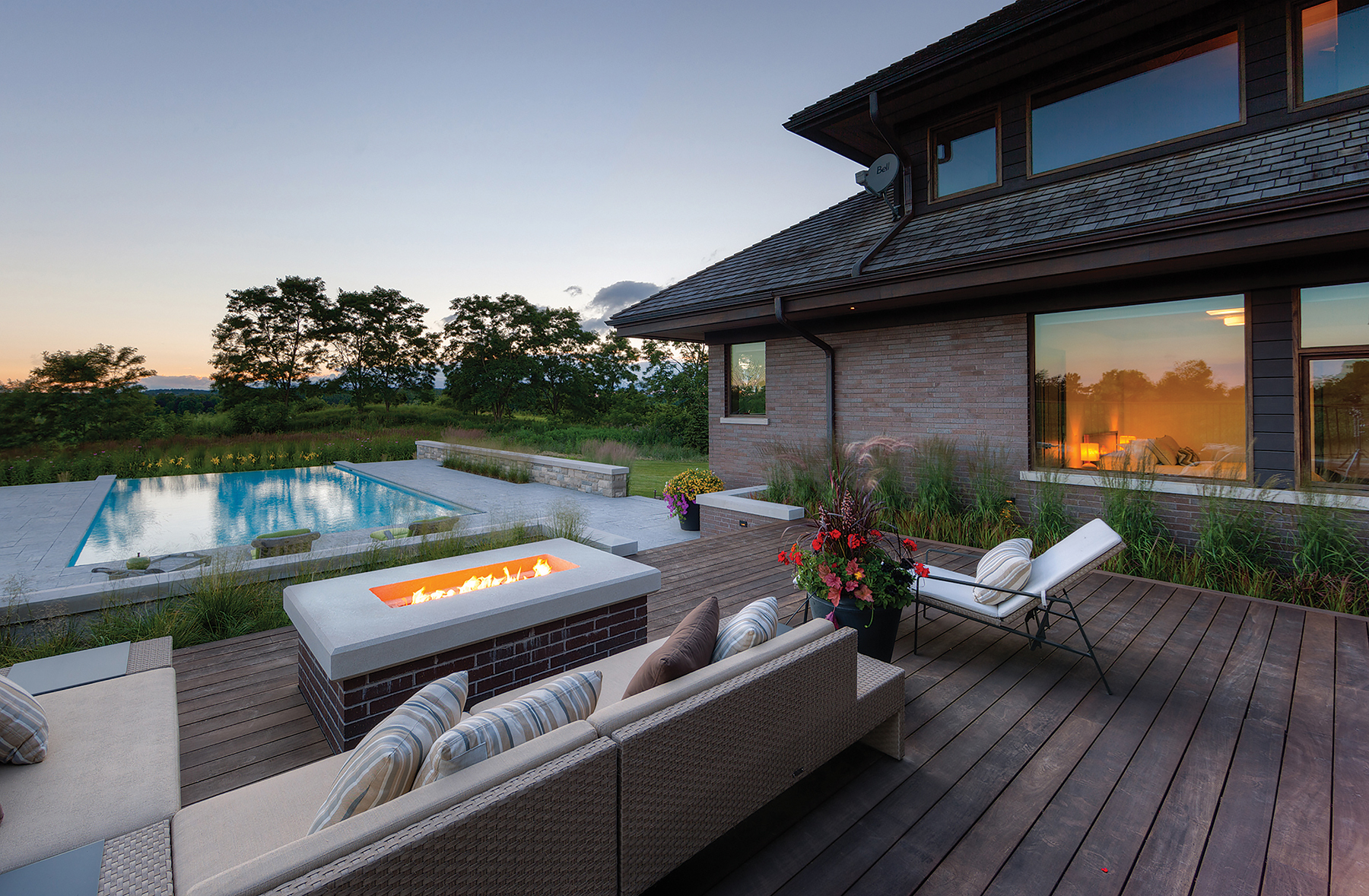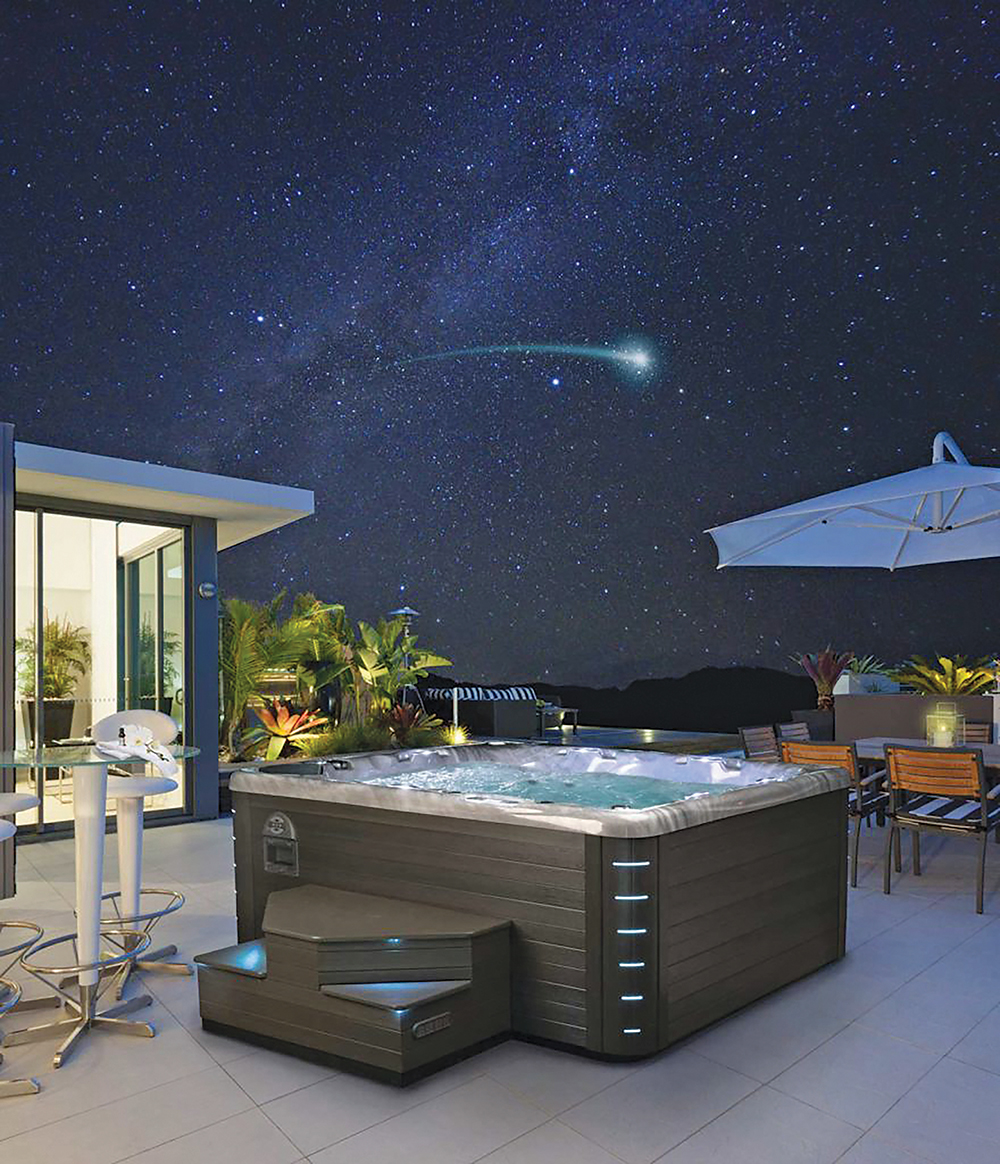Creating an outdoor sanctuary to ride out the pandemic at home this summer
by Judy Ross, photography by Derek Trask
Ah, spring! How welcome it is after the long lockdown winter. The sun warms, trees burst with buds, the grass greens and our focus can finally shift outdoors to the deck, the patio, the backyard emerging from its end-of-winter drabness. What can be done to make everything out there more beautiful and more liveable as we head into summer? If budget and space allow, the ultimate dream plan is a spa-like oasis beyond the back door.
“This has been our busiest year ever,” says Debbie Kerr, owner of Beachcomber Hot Tubs in Collingwood. “It seems that everyone was staying home because of COVID and decided this is the year to get more backyard toys like hot tubs. We were selling out and getting parts became a huge problem.”
So as the supply of products and parts catches up with the demand, there is time to do some research and figure out exactly what will suit your property and your budget. Once some basic decisions have been made about either a pool or a hot tub, you’d be wise to get your order in.
Swimming Pools
When swimming pools first appeared in suburban backyards in the 1950s, they all looked the same: cookie cutter, just like the houses. Most were turquoise rectangles plunked into the lawn, surrounded by concrete and some folding webbed deck chairs.
Today more thought is given to blending the pool with the lie of the land and the architecture of the house. Although rectangular pools are still popular, there’s now an option to have curvy organic shapes that snug into your landscape like a natural pond.
Imaginative designs with lavish surroundings have become standard for inground pools. At the high end, they look like five-star resorts with amenities ranging from cascading waterfalls to swim-up bars, tanning shelves and romantic lighting. The landscaping, sitting areas, fire-pits and outdoor kitchens add to the resort-like ambiance. But the first decision when choosing an inground pool is the material – vinyl lined, concrete or fibreglass.
Vinyl Liners
These are the least expensive and most popular option. They can be installed “in about nine days if the weather is good,” according to Dustin Denis, owner of Pool Products Canada in Collingwood. Most of the pools he has contracted to install this spring are vinyl.
The process involves excavating the site, adding 14-gauge steel wall panels and two to three inches of rough concrete poured into the base. Then a mix of concrete and vermiculite is added to make a smooth surface. The final step is putting the custom-made vinyl liner in place.
Most vinyl pools are the classic rectangular shape, generally twice as long as they are wide. “There’s a trend to linear pools that suit the contemporary aesthetic” says Denis, “A lot of my customers don’t want a deep end or a diving board. The visual appeal is more important than being able to do cannonballs.”
Different colours and patterns are available – black, sandstone, crystal quartz – which can change the overall look. And today’s vinyl is naturally resistant to algae, so it doesn’t require many chemicals. It is also flexible and can’t crack like concrete. Depending on weather (high UV can cause fading) and care, it can last six to 12 years before it may need replacing.
Gunite or Concrete
This is a more expensive option, costing up to $100,000 to put in a custom concrete pool with upgrades, and requires a large team of skilled labourers. A rebar framework is installed first and then sprayed over with a concrete and sand mixture.
These pools can be beautiful and organic looking, and they last longer than other pools. But they require more maintenance because concrete is porous, allowing algae to grow more easily. It is a huge undertaking and can take many weeks to install.
All concrete pools are custom designed so they can be built in any shape or size.

The landscaping, sitting areas, fire-pits and outdoor kitchens add to the resort-like ambiance.
Fibreglass
Fibreglass is a strong, lightweight material constructed by weaving small glass threads into a fabric and hardening the fabric with a special polyester resin. It can be molded into any shape and installed in a few days, faster than other pools. A weather-resistant gel is added for a smooth finish. These are long lasting but hard to repair.
Fibreglass costs more than a vinyl pool but never needs to be replaced like the vinyl liner. The maintenance is cheaper than concrete because it is more algae and stain resistant. It can be slippery – a problem with steps, kids etc. – and the largest size for a fibreglass pool is 16 x 40 feet.
The fibreglass molds are transported in one piece, so you need room for an extra-wide truck to access your property and sometimes a crane to bring it in over the roof of your house.
Lap Pools, Plunge Pools & Swim Spas
Even the tiniest back yard will likely have room for these smaller versions of a swimming pool.
Swim spas are essentially above-ground pools with built-in current jets. They’re like hot tubs but bigger, about 14 feet long. An inground plunge pool, which can be as small as seven feet wide by 12 feet long, is usually deep and used for a quick cool-off on a hot day. Lap pools are similar but longer, shallower and narrower, designed for swimming lengths. These pools are great for small properties, says Denis. “We are installing a small pool this spring, and the client is mainly interested in it for exercise. We are adding a two-nozzle, countercurrent swim jet system (an extra $10,000) which allows for a good workout swimming against the current.”
Pool Add-ons
How you get into the pool is important, so stairs are a popular add-on. Large, wide steps are great for sitting and watching kids, and with a railing they provide a safe and easy access. With a large pool you can have more than one entrance. Stairs placed in a corner can be minimal and hidden from view. A trim tile on the edge of the steps with lighting can create an interesting accent and add an element of safety.
Denis notes that the number one feature that all new pool owners want is a raised wall, one-and-a-half to two feet tall, on one side of the pool with a built-in waterfall. The calming sound and the appearance of splashing water makes the pool setting more natural.
Another popular choice is an automated system that can be operated from your smart phone. This allows you to sit by your pool and dim the lights, increase the intensity of the water falls, and play with the jet sprays.
Denis adds that self-cleaning pools are also in high demand. “Every time I present this concept to customers putting in a new pool, they have gone for it.” He notes. “It has to be installed at the time the pool is being built and it adds another $7,000 to $8,000 to the job, but it is worth it.” For less money (about $1,500) you can choose the popular cleaning robot, which gets dropped into the pool and automatically takes care of the cleaning.
Another frequently requested amenity is a tanning ledge or sun shelf – a raised area with a water depth of about six inches inside the pool. It is designed for relaxing with an option of built-in lounge chairs. This shallow shelf also gives young kids a comfortable place to splash around.
For a ‘lifestyles of the rich and famous’ approach, some homeowners are opting for pools with infinity edges – special pool walls that create the illusion of a vanishing edge. Instead of coping at the top of the pool wall, there’s a dip where water flows over. When you’re in the water it looks as if the pool blends into the horizon. These are great on an elevated country property where you can create the feeling of water falling over a cliff.
Since the pandemic when all nightlife (pubs and restaurants) was shut down, there is more need than ever for private outdoor spaces to be useable after dark, so lighting is a key element for both safety and mood-setting. LED lights, up-lighting in surrounding shrubs, and sidelights are available in a range of colours. All can be programmed and run from smart phones.
Hot Tubs and Spas
Lockdowns have resulted in some products becoming ‘must-have’ items, and hot tubs are at the top of the list. Relieving stress became a priority and when gyms and fitness centres were shuttered, the need for ‘at-home’ solutions sent homeowners rushing to buy hot tubs.
One of the first considerations is having the space and a good location for a hot tub. This may seem obvious, but there are often miscalculations. You need a minimum of 10 square feet to install a hot tub. The placement is also important. You don’t want to trudge through the back yard in cold weather to get to your spa, so placing it close to a door is essential. The further it is from the entrance to the house, the less it will be used.
The number of hot tub styles and models can be overwhelming, which is why Beachcomber began an assessment program to help buyers find something that suits their needs and budget. “We invite the family to come to the showroom (or we can now do this virtually) so we can assess their needs.” says Debbie Kerr. “We look at the size of the people. If you’re tall, you need a tub with deeper seating. The idea of a hot tub is to be submerged; if you’re not you can be a frozen popsicle.”
The price for hot tubs ranges from about $6,500 to $20,000 depending on size and amenities. The three main reasons to buy one are to entertain, to relieve pain, or to simply relax. If you plan to host hot tub parties, then clearly a larger one will be necessary.
The maximum size is about 90 x 94 inches and can seat eight people. The most common size is 84 x 84 inches, suitable for four or five people.
Your lifestyle will determine the size required. But be aware the larger the hot tub, the higher your electrical bill.
Lee-Anne Greig, manager of Clark Pools and Spas, recommends getting an assessment from an electrician before purchasing a hot tub. “Find out how easy, or not, it will be to hook up to the electrical panel in your home,” she says, “It can sometimes be more involved than people think, depending on how far your panel is from the hot tub.”
If you need a hot tub for hydrotherapy (relief from arthritis, achy joints, etc.), the jets will provide a gentle yet effective massage. Enthusiasts say they relieve joint pressure, reduce inflammation and offer pain relief long after you get out of the tub. It’s important to customize the jets for suitable placement depending on what part of your body needs the treatment. Be sure to get enough horsepower for deep tissue massage.
The size, position and power of the jets is key if you need the tub for pain relief. Jets that follow the natural shape of your back are best for back pain: narrow at the bottom and wider at the top near your shoulders.
“People often want to sink the hot tub into their deck because it’s more aesthetically pleasing,” says Greig, “but it can be an issue if something goes wrong and we need to access the pump or drain the system. If the deck is covered in a foot of snow and we have to tear it apart to get at the inner workings, that’s a real problem.”
A hot tub with attractive decking and landscaping will increase the value of your home, unlike a pool which can be a deterrent from a real estate standpoint. One reason is that the hot tub is safer for kids because the lid can be locked. And, unlike an inground pool, it can be more easily moved or removed if not wanted by the homebuyer.
One thing people often overlook is the long-term cost of hot tubs. They aren’t just a one-time expense; you have to consider installation, delivery, electrical hookup, a proper base, decking, landscaping, chemicals and any accessories you might want to add. Good quality hot tubs are made of acrylic, a hard durable plastic resistant to chemicals and UV damage.
Also consider where the pool is made and what the insulation is like. For our cold winters, good insulation means lower energy costs. Some hot tubs that are made in the U.S. are not insulated for our climate. Getting a cheaper ‘good buy’ on a hot tub sometimes ends up costing more in the long run for energy and repairs.
Whether your sights are set on a backyard pool or a deck-top hot tub, the demand for both will likely stay high as long as the pandemic lingers. Both are big investments, so take the time to do your research and make the right choices. Once installed, your spa-like oasis will be there for years to come, long after the pandemic has passed. ❧


















